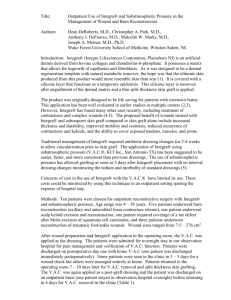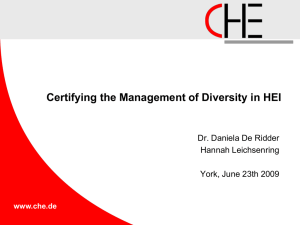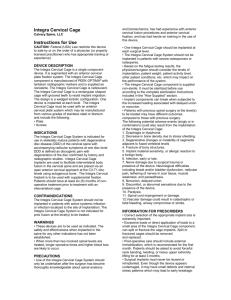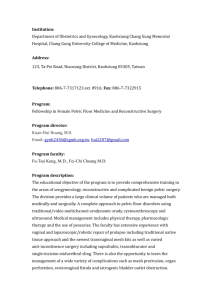Integra in Reconstructive Surgery
advertisement
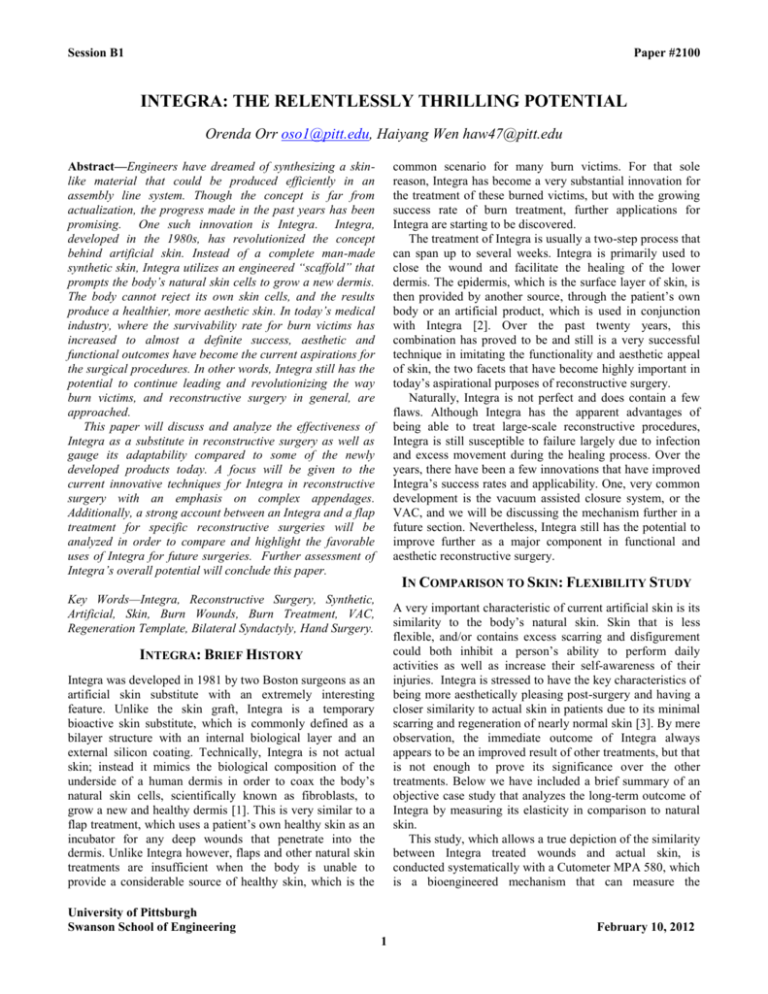
Session B1 Paper #2100 INTEGRA: THE RELENTLESSLY THRILLING POTENTIAL Orenda Orr oso1@pitt.edu, Haiyang Wen haw47@pitt.edu Abstract—Engineers have dreamed of synthesizing a skinlike material that could be produced efficiently in an assembly line system. Though the concept is far from actualization, the progress made in the past years has been promising. One such innovation is Integra. Integra, developed in the 1980s, has revolutionized the concept behind artificial skin. Instead of a complete man-made synthetic skin, Integra utilizes an engineered “scaffold” that prompts the body’s natural skin cells to grow a new dermis. The body cannot reject its own skin cells, and the results produce a healthier, more aesthetic skin. In today’s medical industry, where the survivability rate for burn victims has increased to almost a definite success, aesthetic and functional outcomes have become the current aspirations for the surgical procedures. In other words, Integra still has the potential to continue leading and revolutionizing the way burn victims, and reconstructive surgery in general, are approached. This paper will discuss and analyze the effectiveness of Integra as a substitute in reconstructive surgery as well as gauge its adaptability compared to some of the newly developed products today. A focus will be given to the current innovative techniques for Integra in reconstructive surgery with an emphasis on complex appendages. Additionally, a strong account between an Integra and a flap treatment for specific reconstructive surgeries will be analyzed in order to compare and highlight the favorable uses of Integra for future surgeries. Further assessment of Integra’s overall potential will conclude this paper. common scenario for many burn victims. For that sole reason, Integra has become a very substantial innovation for the treatment of these burned victims, but with the growing success rate of burn treatment, further applications for Integra are starting to be discovered. The treatment of Integra is usually a two-step process that can span up to several weeks. Integra is primarily used to close the wound and facilitate the healing of the lower dermis. The epidermis, which is the surface layer of skin, is then provided by another source, through the patient’s own body or an artificial product, which is used in conjunction with Integra [2]. Over the past twenty years, this combination has proved to be and still is a very successful technique in imitating the functionality and aesthetic appeal of skin, the two facets that have become highly important in today’s aspirational purposes of reconstructive surgery. Naturally, Integra is not perfect and does contain a few flaws. Although Integra has the apparent advantages of being able to treat large-scale reconstructive procedures, Integra is still susceptible to failure largely due to infection and excess movement during the healing process. Over the years, there have been a few innovations that have improved Integra’s success rates and applicability. One, very common development is the vacuum assisted closure system, or the VAC, and we will be discussing the mechanism further in a future section. Nevertheless, Integra still has the potential to improve further as a major component in functional and aesthetic reconstructive surgery. IN COMPARISON TO SKIN: FLEXIBILITY STUDY Key Words—Integra, Reconstructive Surgery, Synthetic, Artificial, Skin, Burn Wounds, Burn Treatment, VAC, Regeneration Template, Bilateral Syndactyly, Hand Surgery. A very important characteristic of current artificial skin is its similarity to the body’s natural skin. Skin that is less flexible, and/or contains excess scarring and disfigurement could both inhibit a person’s ability to perform daily activities as well as increase their self-awareness of their injuries. Integra is stressed to have the key characteristics of being more aesthetically pleasing post-surgery and having a closer similarity to actual skin in patients due to its minimal scarring and regeneration of nearly normal skin [3]. By mere observation, the immediate outcome of Integra always appears to be an improved result of other treatments, but that is not enough to prove its significance over the other treatments. Below we have included a brief summary of an objective case study that analyzes the long-term outcome of Integra by measuring its elasticity in comparison to natural skin. This study, which allows a true depiction of the similarity between Integra treated wounds and actual skin, is conducted systematically with a Cutometer MPA 580, which is a bioengineered mechanism that can measure the INTEGRA: BRIEF HISTORY Integra was developed in 1981 by two Boston surgeons as an artificial skin substitute with an extremely interesting feature. Unlike the skin graft, Integra is a temporary bioactive skin substitute, which is commonly defined as a bilayer structure with an internal biological layer and an external silicon coating. Technically, Integra is not actual skin; instead it mimics the biological composition of the underside of a human dermis in order to coax the body’s natural skin cells, scientifically known as fibroblasts, to grow a new and healthy dermis [1]. This is very similar to a flap treatment, which uses a patient’s own healthy skin as an incubator for any deep wounds that penetrate into the dermis. Unlike Integra however, flaps and other natural skin treatments are insufficient when the body is unable to provide a considerable source of healthy skin, which is the University of Pittsburgh Swanson School of Engineering February 10, 2012 1 Orenda Orr Haiyang Wen mechanical properties of skin in a completely objective manner [3]. The main focus for this study was the mechanical property of elasticity. There were six participants in the case study, all who had been treated with Integra and/or split-thickness skin grafting for a period greater than a year. Both the Integra and SSG treated sites were measured in comparison with the natural skin in each case with the Cutometer MPA 580 in four different elasticity properties: elastic function, gross elasticity, biological elasticity, and viscoelastic ratio. Out of these measurements, Integra was found to have a negative correlation with the natural skin site in each of the elasticity properties while SSG had no correlation [3]. This was just one of the few studies that objectively measured the mechanical properties of Integra due to fact that bioengineered devices, such as the Cutometer MPA 580, have only recently been developed and used in case studies. Though the results may have been substandard, Integra was found to have significant correlations with natural skin, indicting that Integra is a consistent product even if less elastic. On the other hand, the elasticity for SSG treatments is unpredictable at best, with no certainty that the healed wound would be similar to the natural skin. So even though Integra may not be a perfect replica of the biological organ, but it is still consistently analogous compared to other treatments. We will mention another recent study in a future section that will discuss the functionality and strength of Integra treated hand burns, further characterizing the features of Integra. move during the treatment of the reconstructive process [4]. These children were in need of pediatric Integra treatments, which meant that they had wound beds that were often amorphous, uneven, and normally prevented Integra from fixating correctly. The locations included were the shoulder, upper and lower limbs, trunk, and perineal region, giving a total body surface area of 1% to 12%. 18 children were found for the study, and were given Integra VAC treatments for their surgical procedures. Of the 18 children that were selected, 17 had VAC applied successfully with very few complications. In the three weeks that the VAC was applied, most of the Integra treatments fixated to the wound bedding despite the contour of the body, which is a very substantial result given the conditions. Despite a few hitches during the study, the VAC was found to be a very good technique to apply Integra to a wounded bed. [4]. The study may have focused on the use of VAC on children, but even a general application of the VAC on more mature cases can be a significant improvement. y. Unfortunately, there aren’t many circulating studies analyzing Integra with regular dressing techniques, which each have their own limitations, but the addressed study has given the VAC statistical results of its effectiveness as a fixation device. The VAC is far from perfect though since the device is slightly expensive and requires the patient to be confined to the bed for a period of at least three weeks. Nonetheless, the VAC has become a common supplement to Integra related treatments and can be considered as an actual feature that has improved the bilayer’s applicability. Even further use of the VAC can also be seen in the next section discussing the application of Integra on post-burn scars in adolescents and children. NEGATIVE PRESSURE VACUUM-ASSISTISTED FIXATION OF INTEGRA ARTIFICIAL SKIN FOR RECONSTRUCTIVE SURGERY INTEGRA IN RECONSTRUCTIVE SURGERY In our introduction, we mentioned that one of Integra’s sleights is its tendency to be unsuccessful when faced with excess patient movement and infection. This is due to Integra’s application. Integra is a bilayer structure that relies on the fusion between its biological layer and the surface of the burn wound, or the wound bed [4]. If the fixation is not cohesive due to excess patient movement or complex surface areas, the Integra treatment may fail and become infected. Recently, surgeons have implemented a vacuum-assisted closure system (VAC) as a safeguard that prevents contamination by applying negative pressure and prevents movement through its sheer bulkiness. The VAC was first introduced by Argenta in 1997 primarily for the treatment of chronic wound closure. Soon after its development, surgeons started using the technique as a “fixation device for split-thickness skin grafts, STSG, in adults burn patients” [4]. The VAC is a two-step process. First, a “sterile polyurethane ether sponge” is applied directly over the burn wound, which is then covered by a “self-adhesive plastic sheet, connected to an evacuation pump with sub atmospheric pressure” [4]. In this study, the addressed cases were children who are more inclined to Integra, due to its improved elasticity and cosmetic appearance, is known as one of the most widely accepted synthetic skin substitute to be developed for burn patients since its conception [3]. For the past twenty years, Integra has been a major proponent in the surgical reconstructive industry, but Integra harbors the ability and potential to be used in more specialized cases. The following three subsections are documentations of Integra’s use in acute reconstructive procedures that focus both on hands and postsurgical burn revisions. In each subsection, we will note Integra for its favorability in surgical procedures that involve more complicated applications for the burn treatments. Revision Surgery This subsection focuses on surgical procedures that analyze the application of Integra on post-burn scars in adolescents and children. Integra, along with the VAC, were applied to all cases and drastically improved the scar tissues, which originally limited functionality and were disfiguring. This subsection will also solidify the transition between the 2 Orenda Orr Haiyang Wen mechanisms and the surgeries since VAC is a common topic in both. addition, we will further compare the Integra treatment and the more common flap treatment by analyzing the methods, recovery processes, complications, and results of the two. This subsection will tie into our introduction by providing evidence that an Integra treated procedure is more aesthetic and functional than a flap procedure. This subsection will neatly bring readers to the conclusion of this paper. Hand and Upper Extremity We will focus on the hand in the next two subsections, since it is a large focus in our paper. This first subsection will detail Integra’s applications in hand burn surgery in general, noting the methods, complications and results. With this information we will attempt to emphasize that Integra is better suited for delicate anatomical structures in comparison with flaps. This subsection ties into the next subsection due to the similar topic of reconstructive hand surgery. THE RELENTLESSLY THRILLING POTENTIAL This section will conclude our entire paper, and because it immediately follows two specific example of a more recent innovative use of Integra, we will be able to stress the fact that Integra is still a strong component in current surgical trends. This will fulfill the main goal that we had at the start of the paper. Functional Results of Burned Handed Treated with Integra In this third subsection, we will detail the long-term functional evaluation of hand surgeries treated with Integra in order to supply legitimate backing as well as include surgical/financial statistics and/or charts of the procedures. The analysis is conducted by using the 400 Point Evaluation Test, which consists of four separate tests, “motility of the hand, prehension strength, prehension and object displacement with one hand as well as bimanual hand function” [5]. In order to maintain the coherence of the paper, we will briefly summarize Integra’s common applications in reconstructive surgery in order to open up the topic of its new innovative uses. REFERENCES [1] R. Demling, L. DeSanti. (2005). “Managing the Burn Wound.” Burnsurgery.org. [Online]. Available: http://www.burnsurgery.org/Modules/BurnWound%201/sect_VIII.htm. Section VIII [2] D. Roos. (2009 November 04). “Skin Grafts.” HowStuffWorks.com [Online]. Available: http://health.howstuffworks.com/skin-care/information/anatomy/skingraft.htm [3]D. Nguyen, T. Potokar, and P. Price. (2009 July 13). “An Objective Long-Term Evaluation of Integra (a Dermal Skin Substitute) and Split Thickness Skin Grafts, in Acute Burns and Reconstructive Surgery.” Burns. [Online]. Available: http://www.sciencedirect.com/science/article/pii/S0305417909004586. pp. 23-28 [4] D. Stiefel, C. Schiestl, and M. Meuli. (2009, March 18). “The Positive Effect of Negative Pressure: Vacuum-Assisted Fixation of Integra Artificial Skin for Reconstructive Surgery.” Journal of Pediatric Surgery. [Online]. Available: http://www.sciencedirect.com/science/article/pii/S0022346808005988 [5] A. Cuadra, G. Correa, R. Roa, J. Pineros, H. Norambuena, S. Searle, R. Heras, W. Calderon. (2011, October 29). “Functional Results of Burned Hands Treated with Integra ®.” Journal of Plastic, Reconstructive & Aesthetic Surgery. [Online]. Available: http://www.sciencedirect.com/science/article/pii/S1748681511005171 [6] J. Jung, A. Woo, and G. Borschel. (2012 January). “The Use of Integra Bilaminar Dermal Regeneration Template in Apert Syndactyly Reconstruction: A Novel Alternative to Simplify Care and Improve Outcomes.” Journal of Plastic, Reconstructive & Aesthetic Surgery. [Online]. Available: http://www.sciencedirect.com/science/article/pii/S1748681511003597 NEWLY INNOVATIVE USES We will discuss some of the new techniques that utilize Integra today, adding to the previous more common applications. Once again, two accounts will be viewed in subsections in order to continue the flow of the paper. MODIFYING INTEGRA AS A REGENERATION TEMPLATE IN DEEP TISSUE PLANES In this subsection we will discuss the benefits of Integra being used as a tissue regeneration template, which has only been recently applied to reconstructive surgeries. We have up to four cases that have been documented extensively in a source and will be able to supply substantial evidence for Integra’s potential for different applications. We will briefly note one or two cases depending on the future requirements for this paper. ADDITIONAL RESOURCES D. Stiefel, C. Schiestl, M. Meuli. (2010 February). “Integra Artificial Skin for Burn Scar Revision in Adolescents and Children.” Burns. [Online]. Available: http://www.sciencedirect.com/science/article/pii/S0305417909000837. pp. 114-120 J. Frame. (2006 May). “Modifying Integra as Regeneration Template in Deep Tissue Planes.” Journal of Plastic, Reconstructive & Aesthetic Surgery. [Online]. Available: http://www.sciencedirect.com/science/article/pii/S1748681505004122 M. Rizzo. (2011 December 29). “The Use of Integra in Hand and Upper Extremity Surgery.” The Journal of Hand Surgery. [Online]. Available: http://www.sciencedirect.com/science/article/pii/S0363502311014328 THE USE OF INTEGRA IN APERT SYNDACTYLY RECONSTRUCTION This subsection evaluates a study for an Integra and flap treated bilateral syndactylies, a condition in which the appendages of the hands or feet are fused together to the point of disability [6]. This is a very recent study detailing a procedure that has not ever been performed with Integra, and will allow us to once again highlight its potential. In 3 Orenda Orr Haiyang Wen ACKNOWLEDGEMENTS We would like to acknowledge our dedicated writing instructor, Beth Newborg, who has constantly given us guidance in writing this paper despite the many obstacle that have impeded our progress. We would also like to thank our extremely supportive student co-chair, Alicia Kolling, for making sure that we kept on top of our bi-weekly assignments and sent us very encouraging and helpful emails. And of course, we would like to thank our wonderful adult co-chair, Dr. Laura Lund, for working with us on this paper. 4
